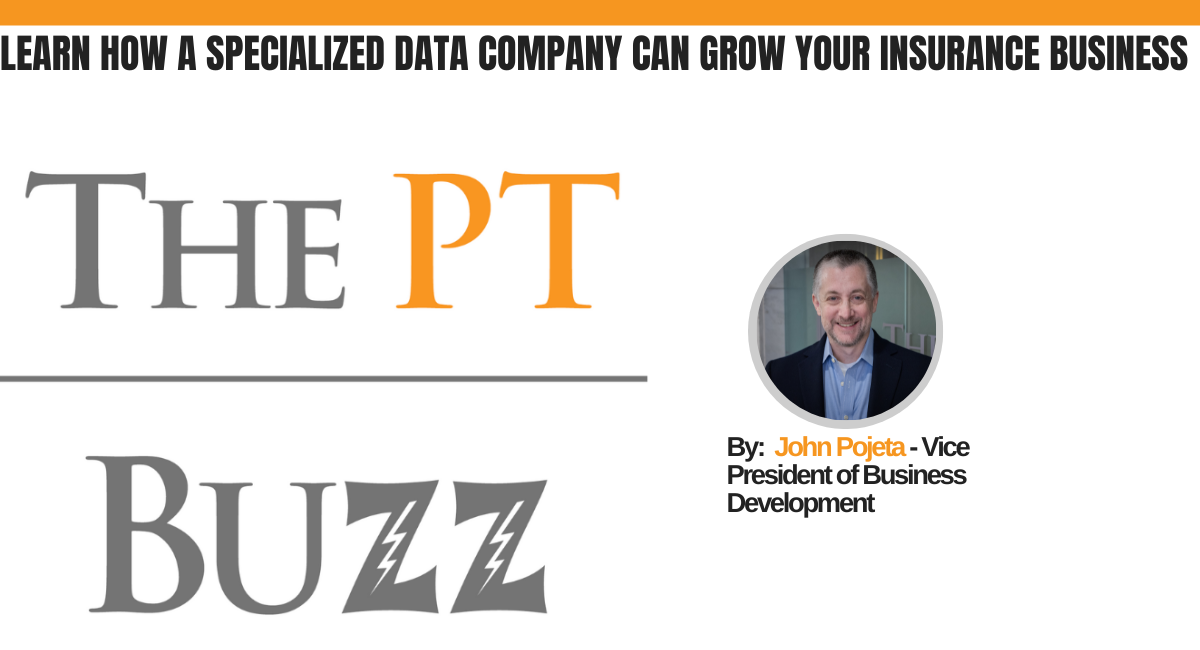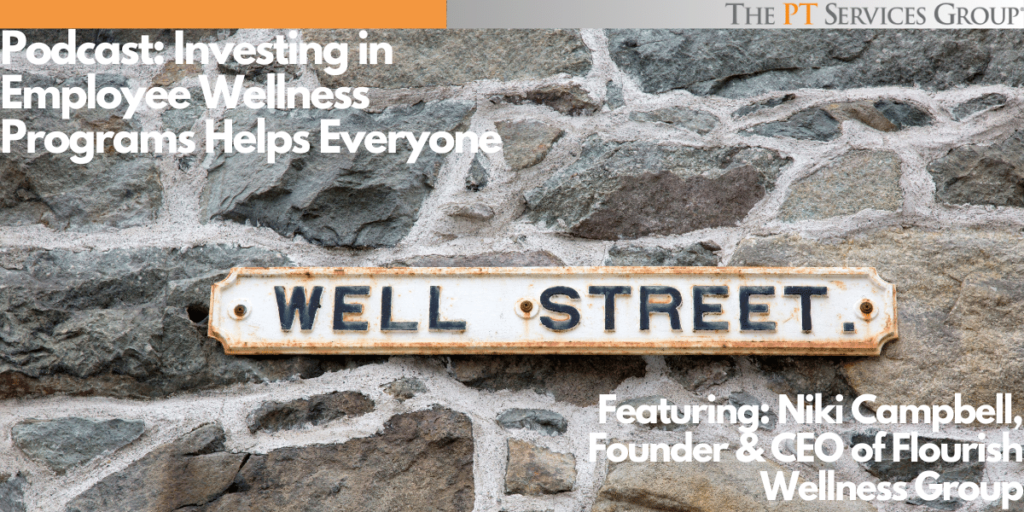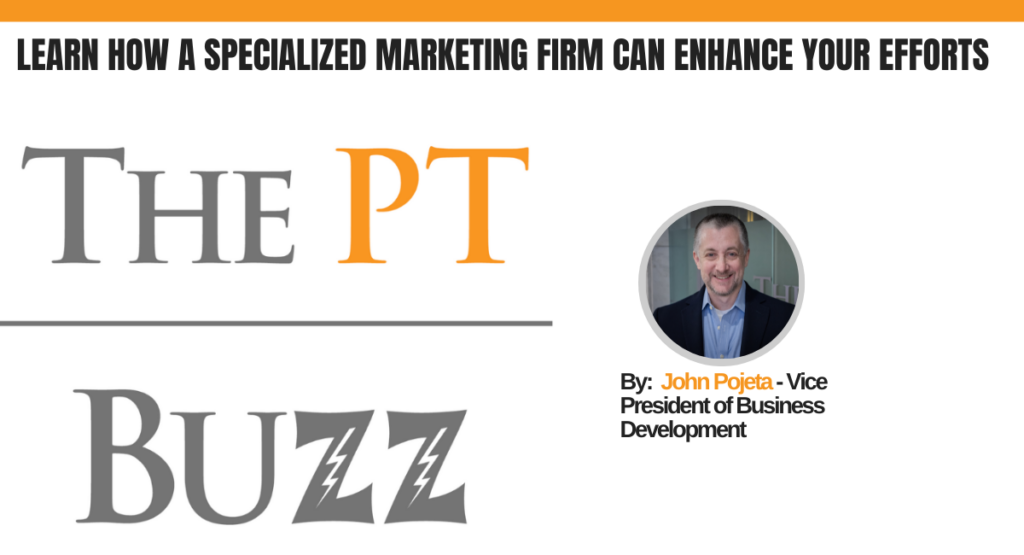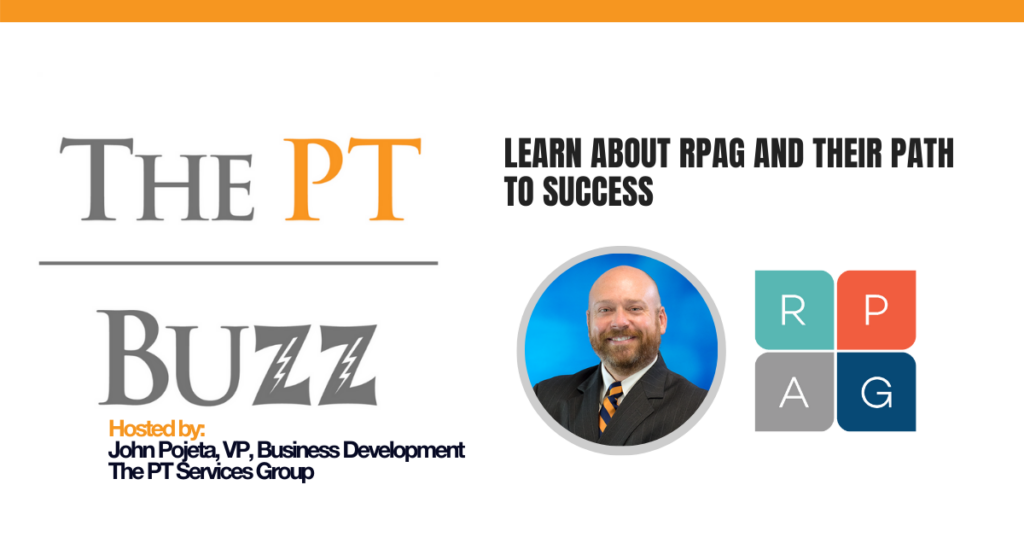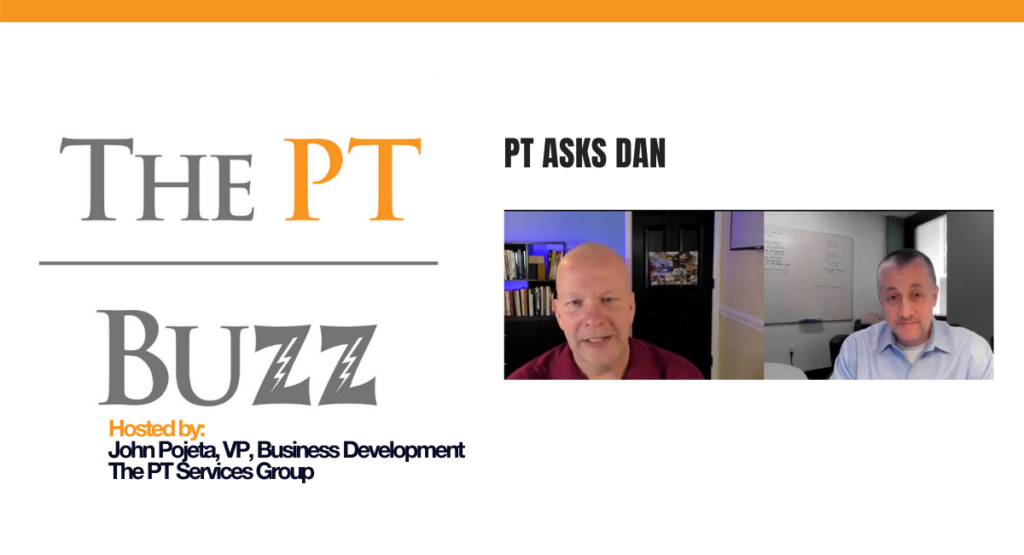PT’s John Pojeta welcomes Founder and CEO of Accupoint Solutions, Gary Weber to the podcast. Accupoint Solutions caters to the Insurance Industry, by providing a database and portal solution which provides information on over 2.56 million insurance professionals and the firms with which they are associated. John and Gary discuss the business and what differentiates their product from others in the industry. This type of information, experience and services can assist firms with their sales, marketing, recruiting and data enhancement efforts. They also tackle some of the challenges faced in the data sector.
Where to Listen/Subscribe














Podcast Resources:
Any and all resources we mentioned in the podcast can be found here. Looking for something not here? Contact us, we’d love to help you out.
Guest Bio:
Gary Weber
Gary Weber is the Founder and CEO of AccuPoint Solutions. He has 35 years’ experience in the financial services industry, working in sales, operations, and data centric roles. In these positions, Gary built, managed, used and reviewed numerous data sources and data related tools that support sales, marketing, recruiting, and data analytics initiatives.
Gary held multiple insurance and securities licenses while in retail sales and sales management positions with Prudential and Dreyfus. He also lead transfer agency and customer service operations as EVP for J. & W. Seligman, and Chief Operations Officer for Morgan Stanley. Leveraging this sales and operational experience, Gary oversaw a team in reviewing 100+ fintech firms, culminating in the purchase of five, all centered around the execution of a new data strategy for Broadridge Financial.
With Gary’s experience, AccuPoint has become a leading privately owned business-to-business data provider with hundreds of quality data points on 2.5 M Insurance Agents, 180k+ Insurance Agencies, and all (750k unique advisors / 44k unique) actively licensed Financial Advisors and Advisory Firms (BDs, RRs, RIAs and IAs). AccuPoint supports thousands of users at firms of all sizes, from one person firms to Fortune 500 Companies. Clients have come to know AccuPoint for its Great Data, Great Service, and Great Value.
Contact information: garyweber@accupointsolutions.com | Office: 888-978-1677 | Website: www.AccuPointSolutions.com
Podcast Transcript:
John Pojeta: Hi everybody. John Jetta here at the PT Services Group. Welcome back to another episode of the PT Buzz and thanks for joining me today for my conversation with Gary Weber from Accu Point Solutions. And Accu Point has a database that a masses great quality information at a here two, four, not found level on advisors and insurance agents.
So it has three buckets. It has an R i a pool, it has a registered rep BD pool, and then it has an insurance. He’s also working on a GA build out, and that’ll be part of the conversation that you’ll hear as well. But if you’re looking to have conversations with advisors or insurance agents, and you want to talk about everything from recruiting, to buying practices, to opportunities relative to products or services that you offer, Gary Webber is the ticket to the data, to the information on who to contact and why. So hope you enjoyed the conversation, and thanks again for joining. How you doing, Gary?
Gary Weber: I’m good, John. Thank you so much.
John Pojeta: Good, good, good. Why don’t we just dive right in, Gary, start with some basics. Can you tell everybody a little bit about yourself and Occupy.
Gary Weber: Sure. Thank you. So, um, I’ve been in the financial services industry for about 35 years now. Um, spent part of my time about 40% on the sales side of the business. So I’ve actually been an insurance agent, an investment advisor, registered rep, wholesaler, sales manager, right up, uh, for firms like Prudential and the Dreyfus funds. Um, I spent about another 40% of my time on the operations side of the business.
So I have run the operations and transfer agency for the Seligman group of funds and was the chief operations officer. Morgan Stanley. So in those positions, um, you know, I have gotten the advantage of being able to say, okay, I’ve sold products and then I’ve supported products that help people sell. Uh, I then went on and spent some time at Broadridge where we set up a data strategy, and then part of my job was to review about 150 companies to execute on that data strategy, which kind of brings me here today, which is, you know, AccuPoint solutions and, and you know, looking at data and how data can help.
Um, as far as, go again. I’m sorry John. I was just gonna say, so you really haven’t done much in the last 35 years, which . No, actually it’s been, I always set myself up to be as much of a generalist as I could, uh, work in all sides of the business cuz I just thought it would be helpful. I, I’m kind of one of those people that always wanted to be an entrepreneur.
Uh, it took me till I was 50 years old to get there. But, um, you know, you always say, Hey, I wish I had done that sooner, but I wouldn’t have had the experience that I had sooner when I was in my twenties or thirties or even forties to do it. So, sure, sure. .
Tap/Click to View Full Transcript
John Pojeta John Pojeta: So take, take us to the Accu Point side. Take us a little bit through the, the basics or, or your, your 32nd commercial kind of approach to it and how it came to be.
What’s the origin story?
Gary Weber: Sure. So, you know, when I, I left the job, I was looking, again, I’m, I’m always one of those people that want to be an entrepreneur, so I was saying, what do I wanna do next? And I ended up doing some consulting for a couple of companies and I looked around and saw the data [00:03:00] that we kind of present now, and I just thought that there was maybe a different or a better way to present it.
I didn’t think that it was being done to the degree from both a quality standpoint and a service standpoint as it should be. So, kind of got lucky in, in the sense that I met a few folks who hadn’t been doing this for a while, but had sourced the same type of data that we do today. Um, and said, listen, uh, I’m kind of at a, a point in my career where I’d like to do something else on my own and kind of pulled them over.
They all happen to be fairly local to where I am. And, uh, not to be disparaging to any of our competitors whatsoever, but they kind of said, look, we’ve learned by our mistakes in, in sourcing or presenting this data before, let’s kind of. Different. Um, so we set up Accu Point Solutions. Uh, we are a privately owned firm at this point.
I think one of the best things that happened to us is we’re self-funded. We bootstrapped it, and that really taught us a lot of things. I mean, you know, when you don’t have a, a 5 million investment or even a million dollar investment, you kind of [00:04:00] say, how can I do this better, faster, stronger, and and more importantly, less expensive?
So we found a lot of ways that we could go out and get data. That I think weren’t even known in the past and created some things that get us data, I think, differently than our competitors do. Um, and that’s where we are today and what we’re told by our clients, many of whom have used our competitors, is that our data is the best that they’ve used.
So that’s good. From our perspective, we always make it clear with folks. Um, it is not perfect. There are so many moving parts. We set that expectation right away, but our validation is our clients.
John Pojeta: Got it. So I guess before we dive into, I wanna talk about the the who and the what. So who tends to use the platform?
Maybe what’s not the right way? Maybe it’s more how it gets utilized, but I think it would help to have a, a little bit more of a picture of your platform. So can you guide people a little bit through sort of the buckets that are on the platform and the some examples of [00:05:00] some of the data that’s in there.
And then we’ll talk about the who and the what.
Gary Weber: Sure. So we are a, a pure business to business play. Um, our data includes information on licensed or registered people and firms. We have about 3 million unique individuals, um, that are about two and a half million insurance agents and about 750,000 unique, um, advisors, registered reps and investment advisors.
And then we have the firm level side of it. We have every broker dealer, every r i a firm. Um, and then we are creating, we’re, we have about 180,000 agencies. Our new agency database, it’s a very unique database. Nobody has it. And as you can imagine, once that’s completed, um, that is just gonna provide even more valuable data to the agent side of it.
Um, our data includes, What you would imagine licensing information, uh, years in the business age, demographic information location. Uh, on the insurance side is things like carrier appointment, detail, lines of authority, license types. On the advisor side, it’d [00:06:00] be things like the exams you passed, series 6 65, your previous employment history, and then at the firm level kind of products that you support and types of fees that you take.
Um, we have. Couple different ways that our clients use our data. Some of them just take straight files from us. Uh, they upload those into their c r m. Sometimes we’ll clean the c r m for them, uh, beforehand. Some of them will take it using our portal. So we have a proprietary search tool that enables you to go in and search and sort.
By a number of those criteria. So you say, listen, I’m looking for an advisor or an agent that is licensed in these states that has this type of, um, licenses or exams that they pass that is between the age of 30 to 50, um, you know, and all these attributes that we have. And then just turn around and our system hit a button and you can download that data directly to your desktop or laptop.
Um, the who’s are. You know, we really run the gamut. It’s, it’s really focused in financial services, but we have small [00:07:00] mom and pop shops and literally single person. Shops out there that are using us, um, straight up to Fortune 500 companies. So we have clients like, uh, Bloomberg and UnitedHealthcare and Guardians.
So, and we like to support both sides of the business, and we’re not looking for just those larger entities. Uh, it’s fun to support both sides of the business. And, you know, we have FMO and IMOs and BGAs and, uh, broker dealers and RA firms as well. And. You know, the reasons are are fairly the same, but they can vary.
So, for example, we’ll have clients that will use us for branding purposes. Let’s find all of those agents or advisors that fit this profile and go out and make sure they know who we are. Um, so branding and marketing. We have clients that will use us for recruiting and r i a firm, A B G A and fmo. They wanna recruit agents or advisors to sell their products.
Um, we have clients that will use us for acquisi. Broker dealer agency, or, um, you know, r i a firm acquisition. [00:08:00] Um, some will use us for pure analytics or use us for other clients. We do have clients that will come in and say, I have a client that needs this. Uh, we need to do some analytics on it. Can you provide us with that data?
So, um, but the core really are those firms that are out looking to market it, to brand, to recruit or to sell. I mean, those are really the, the key of what we do. Um, as I said, the bucket. You asked are are really those segments, which would be the insurance side, which includes the agent and agency databases, the broker dealer side, which includes broker dealer, the firm level with firm level attributes, and then all the registered reps reporting up to them.
And then the RA side, which is the R RA firm level data, and then the iass, all of the investment advisors reporting up to them.
John Pojeta: One of the things you said in there, Gary, that’s really interesting. I’d like you to expand on, cuz I know there’s a lot of interest out there. I know you’ve been trying to work a little bit in your beta phase with it, but that agency database.
Mm-hmm. , can you talk a little bit more about that when that’ll be, I don’t wanna think of it as available because I know you’ve done some work with it now, but can you expand a little bit on some expectations with that?
Gary Weber: Sure. So when we looked at the agent database, and you know, we have people here that have been sourcing and presenting the agent data for 20 plus years now.
Um, and when we looked at that, we saw some gaps in it and, and we said, all right, how do we fill those gaps? And it was basically, let’s go out and source. Agency data. So the difference is on the agent side, where we can tell you the carrier appointments, the license types, the lines of authorities at the agent level.
This is telling you that at the agency level, um, and one of the things that we’ve done is we’ve gone, uh, about a year ago, maybe a little longer, we had about 16,000 agencies. We have 180,000 today. We expect that to go up to about 250. And it’s kind of an iterative process, right? Because you go to one source, you find data, you go to the next one, you find different data, you go back to the first one, you say, okay, um, can we find it?
So what’s gonna be interesting about that is where people are looking for, uh, agent data, for example, and they say, I just wanna recruit agents that look like X. This is saying, I want to go to these agencies that look like X, but talk to the executives there and I wanna find out what’s happening and I wanna talk to them.
The other thing that it’s going to do for us that we’re really excited about and we think, you know, we’ll, we’ll be done and it will be full and complete by the end of the year. And we do have, yes, paying clients on it and people using it cuz it is one of a kind. Um, but we think about how that is just going to add to the agent side of the business.
So imagine when you have the appointment detail, both the agency level and the agent level, um, how you can now take a look and have a good feel for the agents that report up into that agency. So we’re, we’re really excited about. Uh, as you said, we have clients on it using it today, and they’re excited about, and excited for what’s yet to.
John Pojeta: Yeah, no, I, I think that’s a big piece to your point. It’s one of a kind and, um, there’s a lot to be done there as far as engagement with, and, and so it can be very vital. Very vital. Mm-hmm. kinda leads me to you, you touched on it a little bit [00:11:00] and, and certainly respect the commentary, but talk a little bit more about how you differentiate.
I know it’s more data, better data sort of thing, but there’s other things in there in terms of how you differentiate your services and your platforms. Can you talk about that? A.
Gary Weber: Sure, and this is where you might have to cut me off because I can go on and on about this . So we kind of break it up into a couple different buckets.
Um, when we started the firm, our, our main goal was offer the best data we possibly can. And that sounds very elementary, but it’s very easy to get away from. . Um, and what we have here are three individuals of all the people we have working for this firm that literally know where every single data point comes from.
And we all kind of sit in the same place and we talk about it. And if somebody tells us one data point is not good, we literally will research that cuz maybe it’s bringing out other things, maybe it’s not just timing. Um, so we really look at that data. We take it to heart. We make sure that it is something that we do every single day.
Um, and then we get feedback on it, which we think is important. So not only do we have the original architects and we’re not putting, you know, bad data on top of good or good data, on top of bad. Um, we really want feedback from our clients and we want them to challenge us. So when we look at that data, we’ve had clients from time to time that will say, Hey, we don’t think your phone numbers are as good as you think, or, we don’t think your emails are as good as you think.
And we’ll literally go out and either call every number or look at our, you know, we send out millions of emails every month for our clients as a service. So we’ll look at that and we’ll say, well, what’s happening? And inevitably, and I’ll give you just an example. We had a client who said that they gave us a couple lists of phone numbers they thought were bad and we came back with anywhere from 30 to 50% of those phone numbers were good on the three lists they gave us.
And we wanna do that cuz number one, it, it gives us confidence in our data. Number two, it gives our clients confidence in our data. And number three, it brings. Some efficiency. So in this case, what we found out is the clients weren’t using the data properly, right? They would hear, for example, a [00:13:00] landline that’s forwarded to a cell phone.
It’s an aerotone. They just hang up. So we got them more efficient, but we also take it one step further and we said, you know, they would say, oh, also we were looking for X kind of advisor, and we were told by that person that they no longer were in the business. Well, we would go look that up, guess what?
The person’s still in the business. And what we found out was that. Not only are they still in the business that the script that the client was using gave you every opportunity to say, I’m no longer in a business, just to get ’em off the phone. So they were able to alter their script as well from that.
And so it just makes you more efficient. So when we look at the data, we just take it very serious. We do a lot of different things to make sure that the data’s as good as we can get, and it starts there. Service is next, right? So I come from a background where service was very, very important. Um, you know, at Seligman we won awards.
N Q r, Dow Bar, uh, Morgan Stanley, the same thing. And there were certain metrics that you went through and steps you went through to make sure that certain things were done timely. So we wanna make sure, and the example was how we look at the data and then tell people about it and give them the results.
We wanna make sure that you’re serviced properly. And what that means is, you know, we get back to. At, you know, at least same day, if not within an hour when you call us. Um, you know, it’s interesting. We had somebody that worked here a long time ago that said to me once, you know, we’re not saving lives. And my, my response back was, we may not be saving lives, but somebody’s livelihood depends on this.
Somebody is there trying to make their quota 50 calls or a hundred calls, or their sales numbers or analyze things. So we need to get back to these folks on a timely basis. That to us was the number one thing. Get back to everybody. We even have one member of our service team here. I couldn’t figure out what he was doing.
He was always looking at his phone and he had tied his emails to his phone, so his phone would make a noise if he got an email so he can answer it right away. The other side of that service effort is how do we help you? So our goal is if a client calls. or sends us an email or a simple thing says, [00:15:00] Hey, I’m on the road.
Can you, uh, download the save search I had for you? We don’t just download it. We look at it and we’ll say, what are you looking to accomplish? Because maybe you’re looking to accomplish a, but there’s three other best practices we can help you with that tell you, Hey, you should be doing, looking at. C, D and E and that will help you and make those responses back that are as comprehensive as can be, so that we help the client become, you know, as versed at our tool and our data as we are.
And then learn from them too. Cuz sometimes they know more than we do about the data so that from the service end. Again, they’re getting the most value. They come back. That helps everybody. And then the last thing just tends to be our pricing. And it’s always a tough, tough thing because we don’t wanna devalue the data, but we set our company up so that we have lots of variable expenses.
We set it up so that we can offer a lower cost product. And we tend to, out of the gate than any of our competitors we’re, I mentioned that we, we bootstrapped this, um, we are profitable, uh, you know, our cash flow funds, everything that we [00:16:00] do, and. That again, can just add returns back to the.
John Pojeta: Yeah, I, I think what you touched on there with that service side, um, I, I wanna expand on that a little bit.
So , I guess to make it relatable to something, we pt, we’re in the process of evaluating for a new c r m and we get in and we dive in and you start playing around and within five minutes you have 37 questions. And we’d call and they wouldn’t answer. They wouldn’t respond to an email. We couldn’t book a time, we couldn’t.
Info feedback to tie back directly to what we’re looking to do.
In your world, you obviously can provide simply access to the database and somebody can go in there and do their thing and, and in many cases, I know in that five minutes, they quickly start going, that’s a lot of data and I don’t know what I’m doing and I need help.
And Right. I think that layer of how you aid people in determining the data points to use what not to use and things like that is probably more [00:17:00] valuable, um, than people really recognize or can. .
Gary Weber: Mm-hmm. .
John Pojeta: Um, can you touch on that maybe how some of the data overlaps and those different buckets sort of interplay with each other and how you help and support there?
Gary Weber: Sure. Yeah. And it, you know, it comes down to, again, we learn a lot from our clients, right? Because they’ve been in this business, they may know a lot more about a lot of things than we do, but the combination of the two really helps. So, you know, there’s always gonna be some gaps in the data. So, for example, not everybody is going to have a firm name when it comes to the insurance side of the business.
Um, it may not be apparent if a RA firm is an. Firm, they’re selling alts. So what we try to do is work with our clients and say, well, look what makes you think that that works? What makes you think an alt, you know, a firm that’s working with alts looks like? And then we’ll dig into the data and go, Hey, guess what?
We just found an indicator that says that they may be dealing with private funds. Do you think that’s indicative of a firm selling alts? Yes, we do. Okay. What else can we add to it? [00:18:00] And then ultimately we just put that into a save search so they can just click a button later and get The firms are looking to.
Yeah. Another example would be on the, on the, uh, insurance agent side where only about 20, 25% of agents will give you a firm name for lots of reasons. So we’ve developed ways, again, w we’re working with our clients and say, Hey, look, if you click these two or three more buttons, you’re going to. Increase the chances that you’ve either targeted or removed people at those firms where they’re working, getting outside of the firm name, but using other criteria points.
So it it, it’s really, I mean, at the end of the day, all people wanna do is be successful. They wanna get the profile of the firms or, or advisors that they want, and they wanna be able to go out and reach them with good quality information. And again, it, conceptually, it sounds easy, but it’s a lot of work to get there and it’s very easy to get away from.
Yep. Yep, yep.
John Pojeta: Well, you know, one of the things you’ve also helped PT clients with the Times is they’re maybe targeting I’d like to buy practices in this [00:19:00] city or region, or those kinds of things is not just the database access, but really going in and saying, Hey, let me help you build the list. I’m gonna provide you the list.
I’ll help you adjust as you need to over, over the first few months, et cetera. But can you talk about how that can be, uh, uh, an advantage piece in terms of how you engage and interact and provide the, the support you look to provide?
Gary Weber: Yeah, you know, Again, it’s, it’s the data, right? And it’s the quality. So where you all PT services have been real good with us is, you know, that feedback back that you know, you’re only gonna have so much data and there’s certain data points you just can’t get.
It’s just not available out there. So when we look at the calls that you’re making for our clients and the feedback we get from you is really good, right? So, hey, we’ve found that we’re getting a lot of. People that look like X, we need to remove those. So how do we do that? And it starts with that upfront profiling.
It starts with that back and forth about who are you looking for? And sometimes the clients don’t [00:20:00] even know it until you go through with everything. Oh, I didn’t even know I could get there. Okay. And, and again, your firm is really good with helping because of your experience saying, alright, well, what we see is when we call this type of.
Um, you know, they’re only looking for this type of product. So in, in looking at those lists, right, um, and saying what, what is it that we want to get? Um, if we are not looking at the right profile data upfront, then the list is just gonna be garbage. You’re gonna waste your time making those phone calls out.
We’re gonna waste our time. The client’s not gonna be happy. So, you know, Kind of pulling this right back to the question is, yeah, that service end of it and spending the time with the clients is, is a great thing to do. Now, you know, it’s, it’s kind of funny. Uh, somebody here on our service team was laughing one day.
I said, what are you laughing at? He said, you know, I just looked and service reps is like the 12th, worst job in the world. And I said to him, all right, well let me ask you a question. How do you feel about your job? And he said, I feel pretty good about it. And I said, [00:21:00] you know, you gotta remember the reason it’s the 12th worst is because usually there are people on the other end of the phone screaming at you because you promised something that you couldn’t deliver.
You’ve told them you had something that you don’t have. You haven’t taken the time to set their expectations, or you haven’t taken the time to thoroughly go through with them. What it is that they’re looking for. So most of these calls are coming from, you know, people that are angry. We don’t get those calls.
We really don’t. I mean, I’m not saying that everyone, you know, there’s not a person that says, Hey, I didn’t, you know, I got, I got this list and I’m, I’m getting some bad stuff and we’ll work through that. But we’ve never gotten a call about, you know, expectations weren’t set, your data’s not as good as you said it was.
You know, things like that, that we couldn’t. . And so to us it comes down with, you know, always setting those expectations. And, you know, I’ll, I’ll share another story. I of a relative who, who went to a, um, very prestigious college and then got his executive MBA there. Um, you know, if you, if you love football, they’re usually ranked higher than what they [00:22:00] should be.
Um, and, and he came back one day and he went there undergraduate too. His kids went there and he said, I’m so disappointed in my school because what they’re teaching is how you offer just enough. to keep the client but be profitable and, and I don’t agree with that at all. And we don’t agree with it here because I think you can still be profitable and maybe even more profitable by offering up all that service that you need to by helping people with what you know they need to get to.
Whether it’s a service end of it or the data end of it, or just, you know, making ’em comfortable that you have that they’re gonna be with you long term. And that’s kind of how we drive our business. .
John Pojeta: Yeah. I think what you’re touching on is, is very prevalent when it comes to the service side. Most people engage when something’s on fire and to your point when they’re angry about it and everything at that point is too late in, in many, many regards.
But, uh, it’s all in how you go about it. .
Gary Weber: So Yeah. And, and we don’t have a problem telling a client that we may not be a good fit for them. Right. Yeah. Rather than promise ’em we’ll have something in, in six months, or rather than knowing they’re gonna be calling us. We, we’ve said it before to people, we may not be the right fit for you.
John Pojeta: Yeah, no, it’s, it’s, it’s, it’s big. When you’re in a spot where you can comfortably explain the why to somebody and say, Hey, I’m not here just to take the dollars from you. It’s not gonna work. Here’s the background to it. Here’s maybe some resources for you, but it’s just not a good fit as you sit there today.
Gary Weber: And, and to be, and to be frank with you, John, and, and this is kind of my, my commercial for PT services. Um, one of the reasons we’re, you know, we have a partnership with you and there’s a couple of them is number one, I’ve run phone shops before. They’re not easy to run. They take a lot of time, um, to do a good job.
They’re gonna take your effort away from our core business, which is data. Um, and when you and I met, I remember thinking, Your culture is the same as ours. You’re not over promising, you’re not underdelivering. You all, were very frank with, Hey, we’re not gonna get you a thousand leads, but we’re gonna get you X number of really qualified leads and the, you know, that’s more gonna make [00:24:00] up for our cost.
And you know, you all had the exact same personality as we did, which is why I think this works. And you deliver. At the end of the day, you deliver. And at the end of the day, PT services says, Hey, um, if we didn’t do it right for you the first time, Uh, and I know you do it with us. We’ll go back to Accu Point.
Let’s refine that list a little bit based on the calling we have, the additional information we have and let’s get it right. So, um, there are, I think still firms out there like that, you all are one of ’em, and, and that’s why we have the relationship that we do. Yeah, no, it works quite well.
John Pojeta: So let, let’s talk a little bit about that.
Kind of that in between layer. So data on one side, PT making calls further down the line, but there’s that middle ground of, of using email services periodically. Mm-hmm. to engage with large lists. I mean, you, you mentioned upfront almost three and a half million people on the list, let alone the agencies and everything else.
These list gets large, fast. Yes. and you talk about how you utilize email to help clients with [00:25:00] engagement upfront to sometimes whittle us down or grab low hanging fruits, all the different things you can do with email and what that service looks like for you.
Gary Weber: Sure. So from our perspective, you know, and again, this is our frankness, emails aren’t what they were.
10 years ago, 15 years ago. Right. Um, I have people look at me funny sometimes cuz I sell emails as branding first, lead gen second. Uh, I’m old school, you know, when I was in high school I heard that you have to hear a radio ad five to seven times for it to, to click in. It’s the same with email. So it’s about repetition.
Um, so from our perspective, it’s a similar thing I said before. We’ve got emails that go out. If you think that you’re gonna send out a hundred thousand emails today, get 90,000 responses and retire, it’s not happening. But you are going to get enough responses and enough engagement and enough of your client base that it is more than going to pay for itself.
So our services, we try to take the work out of our client’s hands. We do the vast majority of the work, the [00:26:00] setup, the list build, it looks like it’s coming from the client. They will send us our con, their content usually because, You know, we don’t, we’re not marketing folks. We do have a firm that we can work with to do that, and then we do everything straight through, send them reporting within four business days after the campaign goes out.
So they’re very happy with, they’ve got a good solid targeted list. Um, they’ve got a good platform to go out and send out these non optin emails, if you will. And then they get reporting back that they can use as a prioritization tool or to do other things with. And you know, many times, and I’ll, I’ll tell you, you know, 90, 95% of our email clients have been with us for years.
We do get the client every once in a while that they just get nothing and we try to figure out why. Sometimes it’s name recognition, it could be a lot of different things. Um, but what we’re learning too, That is a good way, a very top of the funnel type of thing to do. Let’s send out 50,000, a hundred thousand, 200,000 emails.
They will get business direct from that. But now how do you enhance that? How do you [00:27:00] get more outta your dollar? Well, you do things like make phone calls, so again, engaging PT services, you know, they’re not gonna go out and call a hundred thousand people, but let’s either take the opens, those people that open the email or click through the email or even reply to the.
And let’s go out and call them as in the next round and we’ll work with clients to say, okay, well we called these folks, we got in touch with X number. The rest we didn’t, let’s resend an email to them again. So that’s how we leverage it. We’re also leveraging it with some kind, you know, some what I call digital marketing, right?
Retargeting and programmatic following people around the internet. So we’re doing that as well. And we’re finding the more you can do, the better off you are, especially for some of the smaller firms that don’t have the means or the staffing to, you know, to be able to do that. So it’s that constant repetition, that constant branding that’s happening that we look at and say, okay, this is working and, and you don’t have to.
Completely, you know, there are standalones as you know, we have folks that will just use [00:28:00] us, we’ll send a list to you and they do just phone calls or just emails or just programmatic or social. Um, but there are a lot more starting to do the whole round of it.
John Pojeta: Yeah. And I, I think when, when you get to a list that are really sizable, it, it’s just cost prohibitive to really engage and call a list of 50,000 with the volume of times you need to call to, starting with an email makes a lot of sense that.
Gary Weber: Yep. Yep.
John Pojeta: So talk about the data and the challenges you face with keeping it current, augmenting it. If you’ve got three and a half million people for round numbers in there and let alone the agencies and you have. 50 data points a person. I mean, the, the, the number, the volume gets big. Talk about how you keep it current and up to date for your clientele.
Gary Weber: Sure. So I, I think the first thing is, again, the focus. You’ve gotta focus on the data, right? We don’t write white, you know, white papers. As I said before, we don’t have a phone shop. We focus on the data. That’s number. Number two is making sure that you have good sources. We don’t go out to just any sources, right?
There are data points that, um, some folks will tout that we say, look, we don’t wanna put them in because we don’t trust the source that they come from, and we don’t wanna tarnish our reputation. And by the way, only about 3% of our clients would want that. So we’re willing to lose that business in order to keep the current data points that we have.
So we, we try to make sure that we’re looking at those data points that clients want, and then what we’ve done, which is. You know, well, let me back up. We, we have the institutional knowledge here too, right? Again, we have people that have been doing this for 15, 20 years. We have people with lots of experience that are out there doing it, and then we put in some new people, right?
We wanted that new blood in there. Uh, that now we’ve been here five, six years. That bring a different take to it, and we think that combination has worked. But really what it comes down to is a couple things. Number. Mixing technology with human intervention, right? Our technology such that it’s not only in the front end sourcing, right?
Where do we get the data from and how do we get it electronically? What do we do in the backend? So we’ve got lots of logic and program that [00:30:00] removes data that doesn’t meet our, you know, quality. Standards and it’s because we don’t wanna waste your time. We’d rather lose 10,000 emails than, you know, have you calling those emails or making those phone calls and they’re not there.
So it’s front end, it’s back end through technology. It’s then putting that human intervention in to look at the data that we have and to say, okay, how do we source more? , you’re not gonna get away from that human intervention. So we look at it that way. I think as important though, is that we talk about the data, we talk about any bad data that we have, and then age data and then say how do we make that better?
And then finally it comes down to, and I think the most important point is we’ve done an impact study that is an evolving study that basically says, especially on the insurance side, what are those sources that you need to go to and how often do you need to go to them to keep your data? , and again, it’s never gonna be a hundred percent.
So there may be sources we go to once a month, once a quarter, once every six months, once a year. But we’ve [00:31:00] looked at it so we become efficient and we say, okay, when we do this over the course of a month, six months, a year, we’re impacting the largest percentage of the database that we possibly can.
Therefore, either confirming that your data is good or removing your data because it’s not leaving it blank. inputting new data that you have. So all of that together is what’s, you know, what we’re looking at as far as the challenges. I also think the backend of that though is talking to people about expectations.
Right, so letting people know that it is not a hundred percent here are error rates. Here’s what you can expect, because that then sets everybody in the right tone and says, okay, I get it. You’ve got the best data out there. Your clients are telling you that, but I understand that I’m not gonna call every number and get through to every number.
John Pojeta: So , I laugh just because we’ve had a lot of conversations on our end and behind the scenes about this, but, uh, I don’t have many conversations that don’t involve [00:32:00] chat g p T in some way, shape, or form these days.
Gary Weber: sure.
John Pojeta: Talk a little bit about whether it’s that or just AI in general, how it’s impacting your world and maybe where you see it helping and aiding your process over the next several years.
Gary Weber: Mm-hmm. , so I, I think it’s in its infancy, although there’s probably a lot been done, you know, behind the scenes that we probably don’t know about it. Obviously you’ve got Google and, and Microsoft, the two big ones out there. You know, looking from the search side of it, you know, from our standpoint, we look at it two ways.
Number one is how can it hurt us? And when we look at that, we look at the data and say, you know, our data is so fractured and it’s in so many disparate places, and it’s so dirty. And we tie together data from, you know, not only the advisor side, but the insurance side and the firm side and the individual side, um, that, you know, trying to just ask a question like give me every.
Advisor and agent in the state of Illinois. That’s between this age, you know, that may be 30 years down the road, but that’s not imminent. Um, now that being said, at the end of the day, there’s two ways we think we can use it. Number one, we are a search tool, right? We’re not Google, we’re not Microsoft, but our portal goes in and searches our proprietary database for data.
So number one is how can we. , insert that into our portal that can help our clients with better user experience. So that’s one thing we’re looking at. The second thing then is gonna be, while again, the example of go out to Illinois, go at me, all the agents or advisors, we don’t think that’s coming. How can it help us source our data?
And that’s something I think is a little bit down the road, but. Um, based on all the ways we have today, you know, all technology and all the individual ways and the, the manual intervention that we do, how ultimately can AI help us to source a percentage of our data to make it more efficient, to make it better to cross reference it?
So that’s how we are looking at it. It, it’s still a bit of way, but something that obviously needs to be, [00:34:00] you know, we need to keep an eye on it and need to make sure that we’re leveraging it to the advantage for our clients.
John Pojeta: Yeah. Um, i, I guess there, there’s, there’s a hundred more things we could dive into and get into.
I’d like to ask a catchall question, but just as a reminder, I wanna make sure that there’s not something I’ve missed in terms of what you’ve shared that people should think about. So, if you’re a big company, If, if you’re fidelity and you’re looking to bring your funds and different things to advisors, you’re an annuity company and you want to go to that insurance platform and have access to that all the way through a one person shop that you described that might be interested in buying the practice of, of the woman across town as an example. And everybody in between in terms of how they use the data. Um, are, are there other key points where you’d say, Hey, if you’re not thinking about our data in this way, or, Hey, I wanna leave you with this, we haven’t really touched on that, or are there things like that where you’d say, Hey, if, if you walk away with anything today, this is something you want to think about?
Gary Weber: Well, I, I think there’s obviously, as you said, there’s lots of things to think about. I think just from the standpoint of what haven’t we touched on, it really comes down to some analytics and. Cleansing, right. So on top. Firms going in and looking at us for sales and marketing and things like that. We do have firms that will just ingest our data and mass into these huge data warehouses and do their analytics on it.
And it may be from, you know, some kind of a consulting firm, uh, to the large firms that are just saying, what market should we be in? Where should we be? Where should we be focused? What’s the next product we should be coming out with? Um, so that’s one. And then the second one is just from the cleansing perspective, right?
We have clients that will say to us sometimes, well, yeah, I’ve got this huge database of information. I’ve been in the business for 30 years. And, and the question is, well, how many, well, I’ve got, you know, 150,000 people. Okay, that’s great. How are you getting the new people in? How are you moving the people that are no longer in the business out?
How are you making sure that you’re [00:36:00] keeping up with the data they have, whether it’s contact information, licensing information, and a lot of times these folks don’t have any kind of unique indicator, so we have to go in first and clean the data. We put it through our 60 different matching algorithms we have so that we can say, okay.
Person A is most likely in our database tied to person A in your database. And then we do that put on the unique identifier, and then they’re able to just keep that data clean, you know, whether it’s in their C R M or in their data warehouse. And so those are just other things that we do as part of our core services. Part of the behaviors.
John Pojeta: Yeah. Mm-hmm. . All right. For those who don’t know, final question. Philly or Kansas City who we’re recording this two days before the Super Bowl. By the way. Give everybody the perspective.
Gary Weber: Well, as a longtime Giants fan, oh, there’s just, there’s just, there’s just no way I can root for Philly. So, um, yeah. Uh, let’s just say I’m in it for the boxes.
John Pojeta: There we go. There we go. Yeah, we’re, we’re in Pittsburgh. There are a lot of people that were, uh, rather offended when our mayor of [00:37:00] Pittsburgh congratulated the Eagles when they were going to the suit.
Gary Weber: Yeah, there’s, I, I heard, I heard and you know, some people will say, well, I should root for folks that are in my same division and do all that cuz it’s good.
And, um, but. Uh, John, I know you’re on the East Coast and, you know, there is a, a big rivalry between kind of the, the New York, New Jersey fans and the, uh, even South Jersey, Pennsylvania, Eastern Pennsylvania fans. So it can, it can get nasty, that’s for sure.
John Pojeta: Kansas City and Mahomes. It is. Well, we’ll see. Uh, you know, that’s right.
Gary Weber: I’m, I’m not sure they’re gonna win it, but that’s who I gotta room for.
John Pojeta: No doubt. Well, hey, Gary, greatly appreciate the time. Everyone will have your contact information that’ll tie to this piece if they wanna start a conversation with you, but really appreciate you taking the time, providing the, the, the explanations on the background for Accu Pointin. Um, and a chance for everybody to sort of dive into your story a little bit and see how it can help them.
Gary Weber: Well, and thank you for asking me and I appreciate our relationship as well and the relationship PT has with with Occu Occupy. It’s been great for the last five, six years, so thank you so much for that.[00:38:00]
John Pojeta: Yeah, terrific. On both sides. Absolutely. Thanks so much Gary. Take care.
Gary Weber: You got, have a great day, John.
John Pojeta: Thanks so much everybody for joining in on the conversation with Gary and Accu Point Solutions. Greatly appreciate the time. Please visit us at theptservices group.com/buzz. You’ll see the episode with Gary where you can get contact information if you’d like to reach out to him.
And you can also see all the previous episodes that we’ve done, and if you have any feedback on any of them or you’d like to give some information on somebody you’d like us to interview for an upcoming podcast, please let us know. And again, thank you for your time. Hope you enjoyed the episode and we’ll see you again soon.
